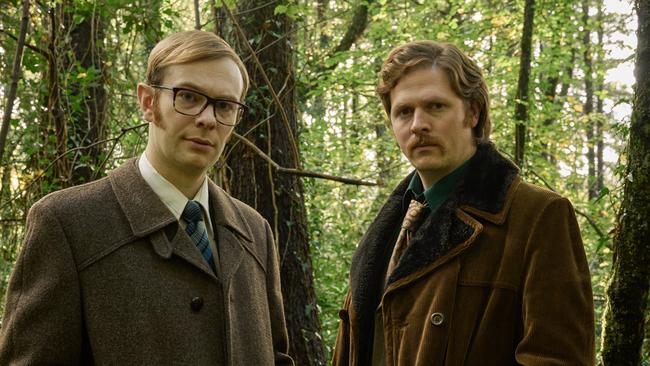Strangled, murdered and dumped: Steeltown killer’s horrific legacy
The cracking of the 30-year-old cold case of the Saturday Night Strangler is ‘a paean to courage, scientific progress and the redemptive power of family’

Debates about the ethics of true crime continue to intensify. One camp finds it all immoral, with too many TV shows exploiting the suffering of victims, especially women. Its enthusiasts see the best of it as being in the public interest in the sense that it investigates the state of policing and criminal justice. True crime can reveal so viscerally how power works, or doesn’t, in a world where government corruption, corporate greed, income equality and human rights violations are common. But the concern lingers.
“Sometimes I think TV should try harder, avoid lazy conceits, stop shoring up the cultural shibboleth that says men are heroes and women natural victims,” critic Lucy Mangan wrote recently. “And sometimes I think men should stop killing women so much in real life, so that television might mercifully follow suit.”
So, there is still much scepticism about why we enjoy true crime in the way we do, and a suspicion we are living through what writer Alice Brolin calls “the post true-crime moment”. This, she argues, “is explicitly or implicitly about the popularity of the new true-crime wave, questioning its place in our culture and resisting or responding to its conventions.”
What we are seeing in the work of directors such as Joe Berlinger and Skye Borgman, for instance, are less voyeuristic presentations consuming real people’s pain for entertainment, but programs created with the consent and inclusion of families of the victims ensuring the depiction of crimes are as respectful as possible.
This brings us to the new BBC production The Steeltown Murders, written by Ed Whitmore. This veteran creator knows a thing or two about compelling narratives of crime, having written many episodes of both Silent Witness and Waking the Dead. These are both shows that deliver stories that explore transgressive actions that seem inexplicable or beyond the police squad’s ability to place within an ordinary sense of reality and order.
He also wrote Manhunt, the factual-based drama starring Martin Clunes, looking at the work of Colin Sutton, who was the Senior Investigating Officer in the hunt for Levi Bellfield, the killer of Marsha McDonnell, Amelie Delagrange and Milly Dowler.
His new series is produced by the resourceful Ed Talfan and Hannah Thomas from Severn Screen, creatively responsible for superb Welsh crime dramas such as Y Gwyll/Hinterland and Craith/Hidden.
The director is Marc Evans, who was responsible for The Pembrokeshire Murders, the police re-examination of two double killings from the 1980s and a sexual assault from the 1990s. Evans was also behind the successful Welsh cop show Hinterland, which brought such Scandi darkness to the coast of Ceredigion.
Steeltown is a dramatised account of the investigation into the rape and murder of two teenage girls in Llandarcy near Port Talbot, South Wales, in 1973. When the bodies of 16-year-old Pauline Floyd and Geraldine Hughes were discovered in woodland, it ignited a major police investigation that saw hundreds of people questioned.
The friends worked together in a local sewing factory, earning 16 quid a week, and went missing after hitching a ride home after a night out at the swanky Top Rank nightclub, Swansea’s top spot. Pauline and Geraldine lived seven miles away in the neighbouring villages of Llandarcy and Skewen. Hitching was popular because it was always awkward getting home when the buses finished at 1am.
Their bodies were found the next morning dumped, raped and strangled, in woodland in the nearby village of Llandarcy, sparking a massive police manhunt for the killer, who becomes known as the Saturday Night Strangler. This left the community cowering in fear as to when or where the killer might strike again; doors were locked against the predator and young women were forbidden to leave the house after dark.
Unfortunately, it takes time for it to become clear that the same killer had struck two months earlier in a very similar attack. Sandra Newton, also 16, had been found murdered and her body dumped near a disused colliery. She had been out with her boyfriend in nearby Briton Ferry when she disappeared on her five-mile walk home at about one o’clock in the morning. She was strangled with her own skirt. The failure by the police to link the murders was a major factor in the eventual abandonment of the investigation.
The case is mired by police incompetency and goes cold before being solved 30 years later by the pioneering use of DNA and the forensic breakthroughs of the early 2000s. Three decades of grief and suffering on behalf of families and their community was the result. Heartache and deep anguish also plagued several police, central to the original investigation, who felt they had failed the victims.
“Almost immediately, I could see that as a piece of true crime drama this would be a challenging evolution from Manhunt in terms of theme, scope and emphasis,” says Whitmore. “Because ultimately the focus would be less on the murders themselves and more on their tragic aftermath – the bereaved families stoically toiling on without justice; the suspects whose lives and marriages have been blighted by suspicion; the detectives tasked with catching the killer serving out their careers in the shadow of failure.”
While on the one hand it’s a story of police ineptitude and clumsiness, the inquiry eventually drowning in the paperwork it creates as thousands of potential suspects are investigated, it’s also one of eventual painstaking, diligent and collaborative policing.
Whitmore’s story begins in 2002 when a patient scientist working alone in a deserted laboratory, eating a green apple – Whitmore’s script loves finding light moments that aerate the gloominess – discovers something. The investigations into the murders had been occasionally reviewed over the years but it wasn’t until 1998 that an advance in DNA meant the girl’s clothing, which had been kept by police, was swabbed for testing.
It takes two years before a genetic profile is extracted from Geraldine’s clothing; the killer’s DNA is mixed in with the 25-year-old samples.
DCI Paul Bethell, played by Philip Glenister with effortless authority as a character determined never to be overpowered by the dark tides of unreason, is placed in charge of Operation Magnum. His objective: to further investigate the DNA breakthrough. A junior cop at the time of the murders, he’s been haunted by the failure to catch the killer and is sure that he knows his identity.
His associates are Phil “Bach” Rees (Steffan Rhodri) and DC Geraint Bale (Gareth John Bale), both 30-year veterans nearing retirement. Aware of the complexities of human motive, their uncommonness is a mask for uncommon qualities and they are the perfect offsiders for Bethell.
He reassembles the Llandarcy murder room in a run-down police station, now a dilapidated storage facility groaning with piles of dusty old files, in the village of Pontardawe, close to the murder scenes.
It’s beautifully filmed by Sam Thomas who cinematically recreates both periods with exemplary polish. And Evans’s direction while sensitive and empathetic still manages to create an emotional equivalent of turn-the-page tension. Their plan is to DNA swab the most likely suspects, but the squad has a budget just for 500 swabs – there are more than 35,000 names in the files. There are also ethical risks. “What if all we do is upend their lives, rip off the scabs that have helped them carry on – where’s your closure then?” Rees asks his boss.
It’s an enormous undertaking as no previous unsolved British murder, had ever been solved so long after the event. But their meticulous work would eventually lead to an exhumation on a sodden hillside cemetery in South Wales and the solution to the murders.
Whitmore’s script effortlessly segues between the different time zones. Scott Arthur and Sion Alun Davies play Bethell and Rees as younger men, while a younger Bale is played by his actor nephew Gareth John Bale. Editor Tim Hodges deserves a round of applause for maintaining the complex intercutting structure in such a way that it’s never confusing but, in fact, illuminating.
As director Evans says, Whitmore gives us two interwoven period dramas, one informing and mirroring the other. “It’s difficult to manage two narratives in a way, but hopefully interesting – the question asked by one investigation perhaps answered by the other and sometimes the other way around.”
Whitmore found that as a dramatist, the chance to sensitively and respectfully chart the interweaving lives of these characters was a gift. “And just as the narrative balances two time frames, I was struck and compelled by the almost in-built thematic equilibrium at the heart of the piece,” he says. “Yes, it’s indelibly a story of loss, regret, monstrous evil and the cruelty of fate – but it’s also a paean to courage, fortitude, scientific progress and the redemptive power of love and family.”
The Steeltown Murders streaming on Foxtel’s BBC First.


To join the conversation, please log in. Don't have an account? Register
Join the conversation, you are commenting as Logout